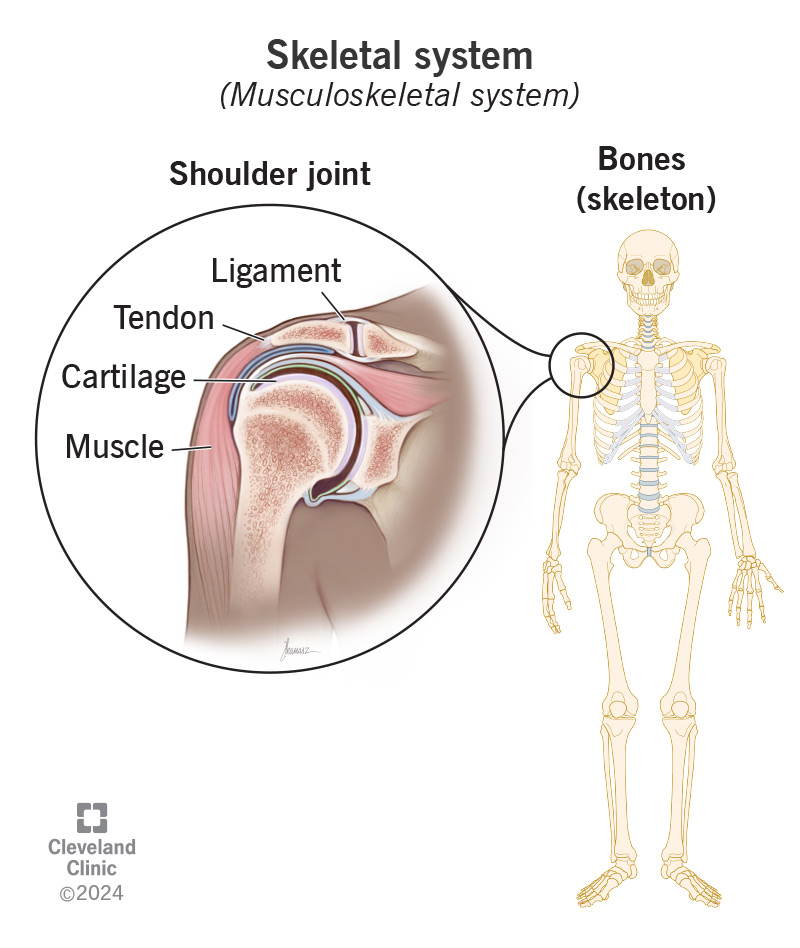The skeletal system is your body’s support structure. It gives your body its shape, allows movement, makes blood cells, provides protection for your organs and stores minerals. The skeletal system is also called the musculoskeletal system.
Advertisement
Cleveland Clinic is a non-profit academic medical center. Advertising on our site helps support our mission. We do not endorse non-Cleveland Clinic products or services. Policy

The skeletal system gives your body its shape and holds your organs in place. In the simplest terms, your skeletal system is your body’s most important support structure. But it’s more than just your skeleton and bones.
Advertisement
Cleveland Clinic is a non-profit academic medical center. Advertising on our site helps support our mission. We do not endorse non-Cleveland Clinic products or services. Policy
Your skeletal system also includes connective tissue that helps you stay supported and safe while you’re moving and still. It includes muscles that help you move and creates new blood cells that keep you healthy. The skeletal system is also called the musculoskeletal system.
The skeletal system has several jobs, some of which are easier to see and feel than others. But they’re all important to your body and health. Your skeletal system’s major functions include:
Advertisement
If you’re picturing your skeletal system, you might think of the plastic skeleton your science teacher used to keep in their classroom. It does contain all your bones, but your skeletal system has lots of other tissue, too. Your skeletal system is made of your:
Lots of common health conditions and injuries can affect your skeletal system because it’s such an important part of how you use your body.
Anything that damages your bones or connective tissue affects your skeletal system, including:
Many autoimmune diseases affect the skeletal system (especially joints). Some of the most common include:
Traumas like falls, car accidents and injuries often damage your skeletal system. Some of the most common injuries include:
Because so many conditions and injuries can affect your skeletal system, you might experience lots of different symptoms. Some common symptoms include:
A healthcare provider will suggest tests based on where you’re experiencing pain or other symptoms. You might need:
Your skeletal system shouldn’t need treatment unless you have a health condition or experience an injury. Your provider will suggest ways to treat what’s causing your symptoms and help your body heal. Some common treatments include:
Advertisement
Following a diet and exercise plan that’s healthy for you will help you maintain your bone (and overall) health. Seeing a healthcare provider for regular checkups can also help catch any issues or symptoms that affect your skeletal system as soon as possible.
Follow these general safety tips to reduce your risk of an injury:
Advertisement
Your skeletal system is the framework that holds the rest of your body in place. You use your bones, muscles and connective tissue constantly, whether you’re a championship athlete or sitting on the bus reading this article on your phone.
Visit a healthcare provider if you notice new pain, stiffness or other symptoms. They’ll help you understand what’s causing your symptoms and how you can get back to your usual routine.
Advertisement
Cleveland Clinic’s primary care providers offer lifelong medical care. From sinus infections and high blood pressure to preventive screening, we’re here for you.

Last reviewed on 01/10/2024.
Learn more about the Health Library and our editorial process.